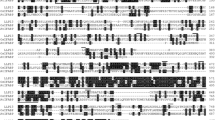Abstract
Pis 30, a gene highly expressed in Brassica napus pistils and encoding a novel proline-rich protein was isolated and characterized. Sequences homologous to the Brassica Pis 30 gene were found only in Arabidopsis thaliana. The Pis 30 gene encodes a mature protein of 8.4 kDa with no previously characterized protein domains and whose function remains unknown. PIS 30 contains especially high levels of Pro (33%), but also of Leu (14%), Phe (10%) and Ser (6%). Although it is a proline-rich protein, PIS 30 shows only limited similarity to previously characterized plant proline-rich proteins. When compared to the stigma-specific activity of the B. napus SLR1 gene promoter in pistils of transgenic Arabidopsis, an 808 bp Pis 30 promoter fragment directed β-glucuronidase expression primarily in the ovary, as well as in the stigma.



Similar content being viewed by others
References
Baldwin TC, Coen ES, Dickinson HG (1992) The ptl1 gene expressed in the transmitting tissue of Antirrhinum encodes an extensin-like protein. Plant J 2:733–739
Balzergue S, Dubreucq B, Chauvin S, Le-Clainche I, Le Boulaire F, de Rose R, Samson F, Biaudet V, Lecharny A, Cruaud C, Weissenbach J, Caboche M, Lepiniec L (2001) Improved PCR-walking for large-scale isolation of plant T-DNA borders. Biotechniques 30:496–504
Cavell AC, Lydiate DJ, Parkin IAP, Dean C, Trick M (1998) Collinearity between a 30-centimorgan segment of Arabidopsis thaliana chromosome 4 and duplicated regions within the Brassica napus genome. Genome 41:62–69
Chang S, Puryear J, Cairney J (1993) A simple and efficient method for isolating RNA from pine trees. Plant Mol Biol Rep 11:113–116
Chen C-G, Cornish EC, Clarke AE (1992) Specific expression of an extensin-like gene in the style of Nicotiana alata. Plant Cell 4:1053–1062
Chen C-G, Mau S-L, Clarke AE (1993) Nucleotide sequence and style-specific expression of a novel proline-rich protein gene from Nicotiana alata. Plant Mol Biol 21:391–395
Cheung AY, May B, Kawata EE, Gu Q, Wu H-M (1993) Characterization of cDNAs for stylar transmitting tissue-specific proline-rich proteins in tobacco. Plant J 3:151–160
Clough S, Bent A (1998) Floral dip: a simplified method for Agrobacterium-mediated transformation of Arabidopsis thaliana. Plant J 16:735–743
Datla RSS, Hammerlindl JK, Panchuk B, Pelcher LE, Keller W (1992) Modified binary plant transformation vectors with the wild-type gene encoding NPTII. Gene 211:383–384
Du H, Simpson RJ, Clarke AE, Bacic A (1996) Molecular characterization of a stigma-specific gene encoding an arabinogalactan-protein (AGP) from Nicotiana alata. Plant J 9:313–323
Dzelzkàlns VA, Thorsness MK, Dwyer KG, Baxter JS, Balent MA, Nasrallah ME, Nasrallah JB (1993) Distinct cis-acting elements direct pistil-specific and pollen-specific activity of the Brassica S-locus glycoprotein gene promoter. Plant Cell 5:855–863
Fiebig A, Kimport R, Preuss D (2004) Comparisons of pollen coat genes across Brassicaceae species reveal rapid evolution by repeat expansion and diversification. Proc Natl Acad Sci USA 101:3286–3291
Foster E, Schneiderman D, Cloutier M, Gleddie S, Robert LS (2002) Modifying the pollen coat protein composition in Brassica. Plant J 31:477–486
Goldman MH, Pezzotti M, Seurinck J, Mariani C (1992) Developmental expression of tobacco pistil-specific genes encoding novel extensin-like proteins. Plant Cell 4:1041–1051
Hackett RM, Cadwallader G, Franklin CH (1996) Functional analysis of a Brassica oleracea SLR1 gene promoter. Plant Physiol 112:1601–1607
Koncz C, Schell J (1986) The promoter of TL-DNA gene 5 controls the tissue-specific expression of chimaeric genes carried by a novel type of Agrobacterium binary vector. Mol Gen Genet 204:383–396
Robert LS, Allard S, Gerster JL, Cass L, Simmonds J (1993) Isolation and characterization of a polygalacturonase gene highly expressed in Brassica napus pollen. Plant Mol Biol 23:1273–1278
Robert LS, Lévesque-Lemay M, Gerster JL, Hong H-P, Keller W (1999) Analyses in transgenic tobacco of the promoter from a Brassica napus gene highly expressed in the stigma. Plant Cell Rep 18:357–362
Schultz CJ, Hauser K, Lind JL, Atkinson AH, Pu Z-Y, Anderson MA, Clarke AE (1997) Molecular characterisation of a cDNA sequence encoding the backbone of a style-specific 120 kDa glycoprotein which has features of both extensins and arabinogalactan proteins. Plant Mol Biol 35:833–845
Schuster DM, Buchman GW, Raschtchian A (1992) A simple and efficient method for amplification of cDNA ends using 5′ RACE. Focus 14:46–52
Sommer-Knudsen J, Clarke AE, Bacic A (1997) Proline- and hydroxyproline-rich gene products in the sexual tissues of flowers. Sex Plant Reprod 10:253–260
Spertini D, Béliveau C, Bellemare G (1999) Screening of transgenic plants by amplification of unknown genomic DNA flanking T-DNA. Biotechniques 27:308–314
Stein JC, Dixit R, Nasrallah ME, Nasrallah JB (1996) SRK, the stigma-specific S locus receptor kinase of Brassica, is targeted to the plasma membrane in transgenic tobacco. Plant Cell 8:429–445
Toriyama K, Thorsness MK, Nasrallah JB, Nasrallah ME (1991) A Brassica S locus gene promoter directs sporophytic expression in the anther tapetum of transgenic Arabidopsis. Dev Biol 143:427–431
Wu H-M, Zou J, May B, Gu Q, Cheung AY (1993) A tobacco gene family for flower cell wall proteins with a proline-rich domain and a cysteine-rich domain. Proc Natl Acad Sci USA 90:6829–6833
Wu H, de Graaf B, Mariani C, Cheung AY (2001) Hydroxyproline-rich glycoproteins in plant reproductive tissues: structure, functions and regulation. Cell Mol Life Sci 58:1418–1429
Acknowledgements
The authors would like to thank Martine Racicot, Serge Gravel, Dina Joyal and Chantal Gaudet for technical assistance, Eric Johnson for flower photography and Dr. David Wilkinson and Dr. Robert Watson for critical review of this manuscript.
Author information
Authors and Affiliations
Corresponding author
Rights and permissions
About this article
Cite this article
Foster, E., Lévesque-Lemay, M., Schneiderman, D. et al. Characterization of a gene highly expressed in the Brassica napus pistil that encodes a novel proline-rich protein. Sex Plant Reprod 17, 261–267 (2005). https://doi.org/10.1007/s00497-004-0236-6
Received:
Accepted:
Published:
Issue Date:
DOI: https://doi.org/10.1007/s00497-004-0236-6




